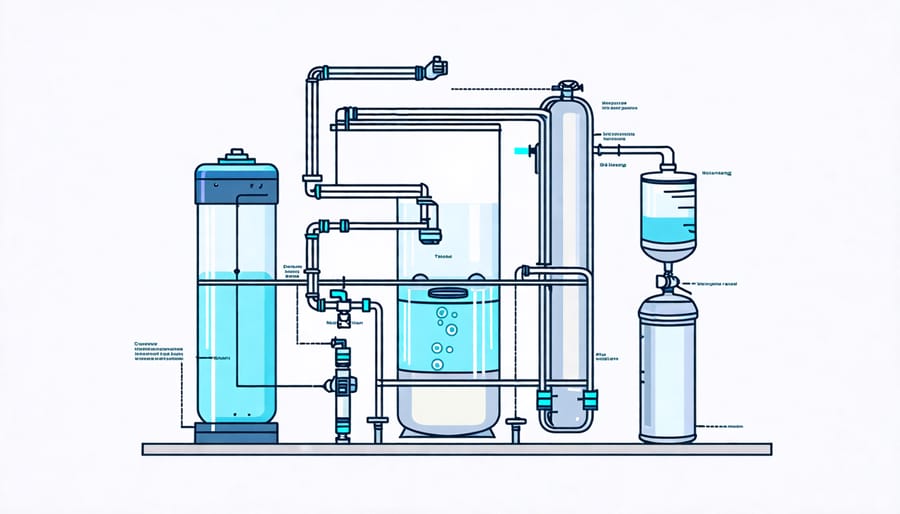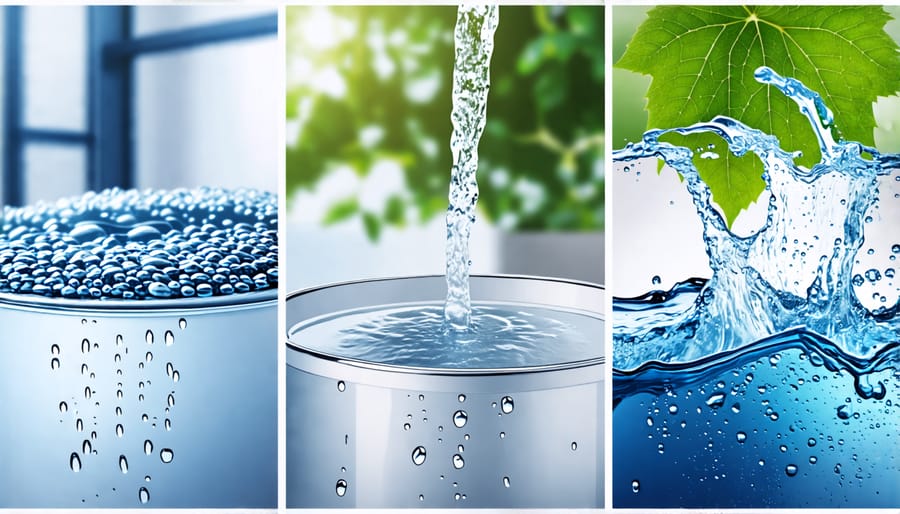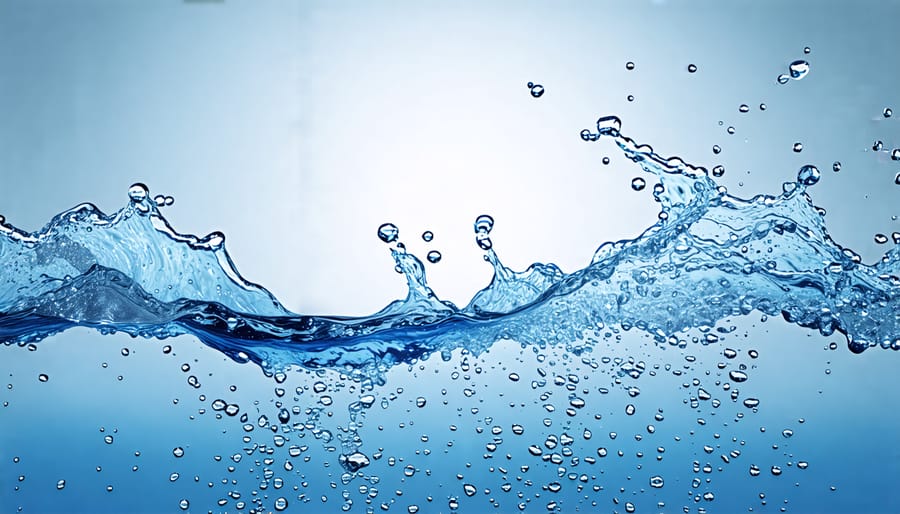Check your water softener monthly for signs of poor performance, such as reduced water pressure, soap scum buildup, or salty-tasting water. Schedule professional service every 1-2 years to optimize softening resin and replenish salt levels. Cleaning a water softener yourself between services can extend its lifespan. Have your water hardness tested annually and adjust softener settings accordingly for peak efficiency.
Understanding Your Water Softener

The Ion Exchange Process
Water softeners work by a process called ion exchange. Inside the softener tank, there are many small resin beads covered with sodium ions. As hard water passes through, the resin attracts the calcium and magnesium ions (which make water “hard”), replacing them with sodium. This “softens” the water. Over time, the resin becomes saturated with hardness minerals and needs to be recharged. The softener flushes a concentrated salt solution through the resin, replenishing it with fresh sodium ions so it can continue effectively softening water. This regeneration process is why softeners need periodic servicing and salt replenishment.
Key Components of a Water Softener
A water softener system typically consists of two main components: the resin tank and the brine tank. The resin tank is where the water softening process takes place. It contains small resin beads that are charged with sodium ions, which attract and remove hardness-causing minerals like calcium and magnesium from the water as it passes through. The brine tank is where a concentrated salt solution, known as brine, is stored. During the regeneration cycle, this brine is flushed through the resin tank to replenish the sodium ions and wash away the trapped hard water minerals, ensuring the softener remains effective.

5 Signs Your Water Softener Needs Servicing
1. Hard Water Spots or Stains
One telltale sign that your water softener may need servicing is the reappearance of hard water spots or stains on your dishes, glasses, and fixtures. These spots are caused by mineral buildup, particularly calcium and magnesium, which are normally removed by a properly functioning water softener. If you start noticing chalky residue or cloudy films on your dishware after washing, or water spots on your faucets and shower doors, it’s a strong indication that your softener isn’t working optimally. Hard water can also leave your hair feeling dry and make your skin itchy after bathing. If you experience these symptoms despite having a water softener installed, it’s likely time to have it serviced by a professional. Catching the problem early can prevent more serious issues down the line and ensure your appliances and plumbing continue to function efficiently.
2. Changes in Water Taste or Odor
If you notice any unusual tastes or odors in your softened water, it could be a sign that your water softener needs attention. A salty taste may indicate that the brine tank is overflowing, allowing excess salt to enter the water supply. A musty or sulfuric smell could mean that bacteria have begun growing in the resin bed. These issues can arise due to clogged injectors, faulty valves, or insufficient salt levels. If you detect any off-flavors or scents, it’s best to have your system inspected by a professional to identify and resolve the problem. Regular maintenance can help prevent these issues and ensure that your softener continues to provide clean, fresh-tasting water for your home. Don’t ignore changes in taste or odor – they’re often an early warning sign that your softener needs some TLC.
3. Reduced Water Pressure
A significant drop in water pressure could indicate an issue with your water softener. If the softener becomes clogged with sediment or the resin bed is exhausted, it can restrict water flow and lead to reduced pressure throughout your home. This problem may be more noticeable in fixtures farthest from the softener unit. To troubleshoot, check the salt level in the brine tank and ensure the softener is regenerating properly. If the issue persists after regeneration, it’s time to call in a professional for servicing. They can inspect the system, clean out any blockages, and replace worn components to restore optimal water flow and pressure. Don’t ignore a sudden decrease in pressure – it’s a sign your softener needs attention to continue providing the soft water benefits you rely on.
4. Increased Salt Consumption
If you notice your water softener using more salt than usual, it may be a sign that the system is not operating at peak efficiency or has developed a malfunction. An increase in salt consumption without a corresponding rise in water usage or hardness often points to an underlying issue that requires attention. Possible causes could include a clogged injector, a problem with the brine tank float assembly, or a malfunctioning regeneration valve. When your softener uses excessive salt, it not only drives up operational costs but can also lead to insufficient regeneration cycles, reducing the effectiveness of the system in treating hard water. If you suspect your softener is consuming too much salt, it’s best to have a professional assess the unit and perform any necessary repairs or adjustments to restore optimal performance and efficiency.
5. Abnormal Sounds
If you hear strange noises coming from your water softener, it may be time for service. Buzzing, humming, or grinding sounds could indicate issues with the motor, valves, or other mechanical components. A loud hammering noise, known as water hammer, suggests problems with water pressure or loose pipes. Hissing or sloshing noises during regeneration cycles may point to blockages or malfunctioning parts within the system. While some occasional sounds are normal, persistent or unusual noises shouldn’t be ignored. If you notice any concerning sounds, it’s best to contact a professional for an inspection to prevent further damage and ensure your softener continues to function efficiently. Addressing these issues promptly can help extend the life of your appliance and maintain the quality of your soft water.
Recommended Service Schedule
The recommended service schedule for a water softener depends on several factors, including the size of your household, water hardness level, and the system’s age. As a general rule of thumb, it’s advisable to have your water softener professionally serviced every 1-2 years. However, if you have a larger family or live in an area with extremely hard water, annual servicing may be necessary to keep your softener running optimally.
During a professional service visit, a technician will thoroughly inspect your system, clean the brine tank, and check for any worn or malfunctioning parts that may need replacement. They’ll also assess the softener’s settings and make adjustments as needed to ensure efficient operation.
If you notice any signs of trouble between service visits, such as a decrease in water pressure, salty-tasting water, or the appearance of scale buildup on fixtures, it’s best to schedule a service call promptly. Catching and addressing issues early can help prevent more serious problems down the line and extend the life of your water softener.
By sticking to a regular maintenance schedule and keeping an eye out for potential red flags, you can ensure that your water softener continues to provide your home with soft, high-quality water for years to come.
Conclusion
Regular water softener maintenance is essential to ensure your appliance continues working efficiently and effectively. By being proactive in scheduling service when needed, you can avoid costly repairs, extend the lifespan of your softener, and maintain the quality of your home’s water supply. Remember to watch for signs of trouble like changes in water quality or pressure, and aim to have your softener serviced at least once a year or more frequently if you have very hard water. With proper care and attention, including basic DIY water softener tune-up tasks, your water softener will keep your home’s water soft, clean, and free of damaging mineral buildup for years to come.





